Why stainless?
What are the benefits? 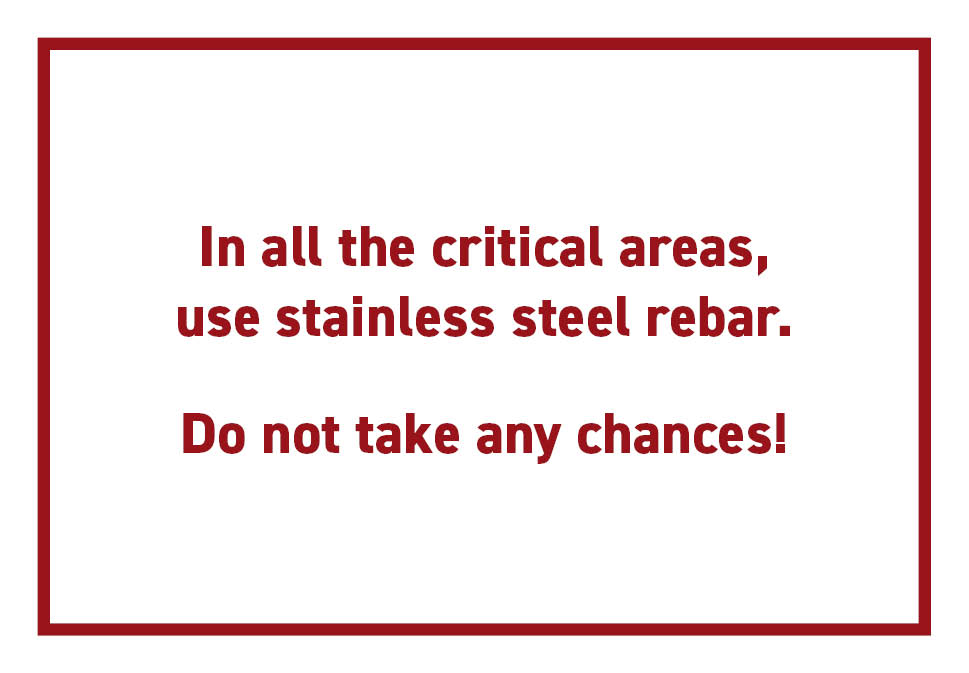
- Because it is highly resistant to corrosion from chloride ion
- It does not rely on the high alkalinity of concrete for protection
- Concrete cover can be reduced
- Concrete sealant, such as Silane, can be eliminated
- Concrete mix can be simplified to suit concrete design needs not for rebar protection needs
- It improves durability
- It reduces maintenance and repair
- It can be used selectively for high risk elements cost-effectively
- It will eventually be recycled
Stainless steels vs. other corrosion protection solutions [15] [16]
|
Advantages |
Drawbacks |
|
|
Epoxy coating |
Lower initial costs |
|
|
Galvanizing |
Lower initial costs |
|
|
Fiber-reinforced Polymers |
Lower initial costs |
|
|
Cathodic protection |
Lower initial costs |
|
|
Membranes |
Lower initial costs? |
|
|
STAINLESS STEEL |
Low Life Cycle cost:
Removes corrosion, hence corrosion-induced concrete cracking |
|
Grade selection
Recommendations of the Technical Center on Consulting for Cement and Concrete, Switzerland [17]:
|
Material of the reinforcement |
Pitting 1) |
Corrosion |
Carbonation of concrete |
||||||||
|---|---|---|---|---|---|---|---|---|---|---|---|
|
No |
Yes |
No |
Yes |
Yes 2) |
Yes 2) |
||||||
|
Chloride content 3) |
|||||||||||
|
Zero |
Zero |
Low |
Low |
Mid |
High |
||||||
|
Ordinary black rebar |
0 |
0 |
+ |
- |
+/- |
(-) |
- |
- |
|||
|
Epoxy-coated rebar |
0 |
? |
4) |
||||||||
|
Galvanised rebar |
0 |
0/1 |
+ |
+ |
(+) |
- |
- |
- |
|||
|
Chromium-Steels 5) |
10-16 |
1 |
+ |
+ |
+ |
(+/-) |
(+/-) |
- |
|||
|
Chromium-Nickel-Steels and Chromium-Nickel-Molybdenum-Steels |
|
17-22 |
2 |
+ |
+ |
+ |
+ |
+ |
(+) |
||
|
Chromium-Nickel-Molybdenum-Steels |
|
23-30 |
3 |
+ |
+ |
+ |
+ |
+ |
+ |
||
|
Chromium-Nickel-Molybdenum-Steels |
|
>31 |
4 |
For special cases e.g.:
|
|||||||
|
1) WS: Pitting resistance equivalent calculated according to: WS=%Cr+3.3%Mo+0%N. |
|||||||||||
|
2) The influence of the chloride content dominates. Carbonation is of minor importance since the rate of carbonation is low or the concrete cover is high |
|||||||||||
|
3) Chloride content: |
low: |
≤0.6 M.% in respect to cement content |
|||||||||
|
|
middle: |
≥0.6, but ≤1.5M.% in respect to the cement content |
|||||||||
|
|
high: |
≥1.5, but ≤5 M.% in respect to the cement content |
|||||||||
|
|
very high: |
>5 M.% in respect to the cement content |
|||||||||
|
4) The classification is uncertain/controversial. Comparative considerations and judgement: see Chapter 4.7. |
|||||||||||
|
5) The susceptibility to pitting corrosion of chromium steels with a low chromium content increases rapidly with decreasing pH. Depending on the concrete cover the carbonation of the concrete is, therefore, more or less important |
|||||||||||
Recommendations from:
BSSA (British Stainless Steel Association) Special report (2003) [18]
|
Selection of material Grade for given exposure condition |
|
|
Exposure condition |
Material Grade |
|
Stainless steel embedded in concrete with normal exposure to chlorides in soffits, edge beams, diaphragm walls, joints and structures |
1.4301 |
|
As above but where design for durability requirements are relaxed in accordance with table 3.7. |
1.4301 |
|
As above but where additional relaxation of design for durability is required for specific reasons on a given structure or component i.e. where waterproofing integrity cannot be guaranteed over the whole life of the structure |
1.4436 |
|
Direct exposure to chlorides and chloride bearing waters for example dowel bars, holding down bolts and other components protruding from the concrete |
1.4429 1.4436 |
|
Specific structural requirements for the use of higher strength reinforcement and suitable for all exposure conditions |
1.4462 1.4429 |
Please note, however, that since then lean Duplex grades gained acceptance and are now widely used (please go to stainless properties)
Is Stainless Steel Cost-effective?
Example 1 [19]
ECONOMIC EXAMPLE:*
Total construction costs of a road bridge
|
Solution |
Total bridge cost indications |
|
|
100% |
Carbon Steel Rebar |
100 |
|
10% |
Stainless Steel Rebar |
103 |
|
25% |
Stainless Steel Rebar |
107.5 |
|
50% |
Stainless Steel Rebar |
115 |
|
100% |
Stainless Steel Rebar |
130 |
(*) The calculations are taken from a publication by the French information centre for cementeous materials, CIMbéton. The stainless steel used is grade 304. The numbers will vary with market prices and grade selection. Nevertheless, the indications represent typical road bridge construction experience.
The Progreso pier was built in 1941, using stainless steel rebar. The LCA /LCC comparisons were made with an hypothetical alternative of C-steel rebar. They show that stainless rebar results in a lower Life Cycle Cost and a lower Global Warming Potential.
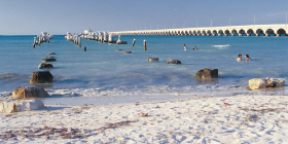

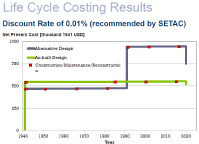
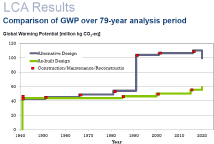
Ministry of Transportation of Ontario, Canada
“The advantage of stainless steel is the extremely slow rate at which it corrodes in a concrete/chloride environment. Minimal corrosion damage is anticipated during a service life of 75 years. Although it is much more expensive to purchase than black or epoxy-coated reinforcing steel, it is more cost-effective over the long term because the corrosion-induced damage typically seen with black steel and coated steel will not occur.”
Comparison of initial cost and life cycle costs of new bridges with various types of deck reinforcing
|
Reinforcing Type |
ECR, Galvanized |
MMFX 2 |
FRP |
Solid Stainless |
EnduraMet© 32 Stainless |
|
Deck cost (compared to total initial cost of “base” structure) |
38.00% |
39.14% |
39.90% |
42.18% |
39.90% |
|
Steel cost (compared to total initial cost of “base” structure) |
31.00% |
31.00% |
30.50% |
30.50% |
30.50% |
|
Foundation cost (compared to total initial cost of “base” structure) |
25.00% |
25.00% |
24.00% |
24.00% |
24.00% |
|
Earthwork, etc. cost (compared to total initial cost of “base” structure) |
6.00% |
6.00% |
6.00% |
6.00% |
6.00% |
|
Total initial cost of structure |
100.00% |
101.14% |
100.40% |
102.68% |
100.40% |
|
Estimated Life (Years) |
40 |
50 |
65 |
100 |
100 |
|
Present worth of deck replacement at end of life |
9.89% |
6.88% |
3.93% |
1.05% |
1.00% |
|
100-year life cycle cost as a percentage of initial cost of “base” structure |
111.48% |
108.02% |
103.88% |
103.74% |
101.40% |
The Schaffhausen bridge across the river Rhine was completed in 1995. The bridge is required to resist to atmospheric corrosion and de-icing salts. The bridge is expected to last 80 years without loss of structural integrity and without significant maintenance.
Three options were considered for the rebar reinforcement:
- Carbon steel: expensive repairs would have been required every 25 years and caused heavy traffic disruption
- Epoxy coated carbon steel: less extensive repairs would nevertheless have to be carried out every 25 years with reduced traffic disruption
- Carbon steel with stainless steel in the critical areas: meets the design life requirements
The comparative costs of the three alternatives are shown below.
Proper use of stainless steel leads to an extra cost of only 0.5%, paid back 30 times by the savings achieved over the lifetime of the bridge!
LIFE CYCLE COST SUMMARY OF A RIVER CROSSING HIGHWAY BRIDGE:
|
Description |
Carbon Steel |
Epoxy C.S. |
Stainless Steel |
|
Material costs Fabrication costs Other installation costs |
8,197 0 15,611,354 |
31,420 0 15,611,354 |
88,646 0 15,611,354 |
|
Initial cost (CHF) |
15,619,551 |
15,642,774 |
15,700,000 |
|
Maintenance Replacement Lost production Material related |
0 256,239 2,218,524 0 |
0 76,872 2,218,524 0 |
0 -141 0 0 |
|
Operating costs (CHF) |
2,474,763 |
2,295,396 |
-141 |
|
Total LCC (CHF) |
18,094,314 |
17,938,170 |
15,699,859 |
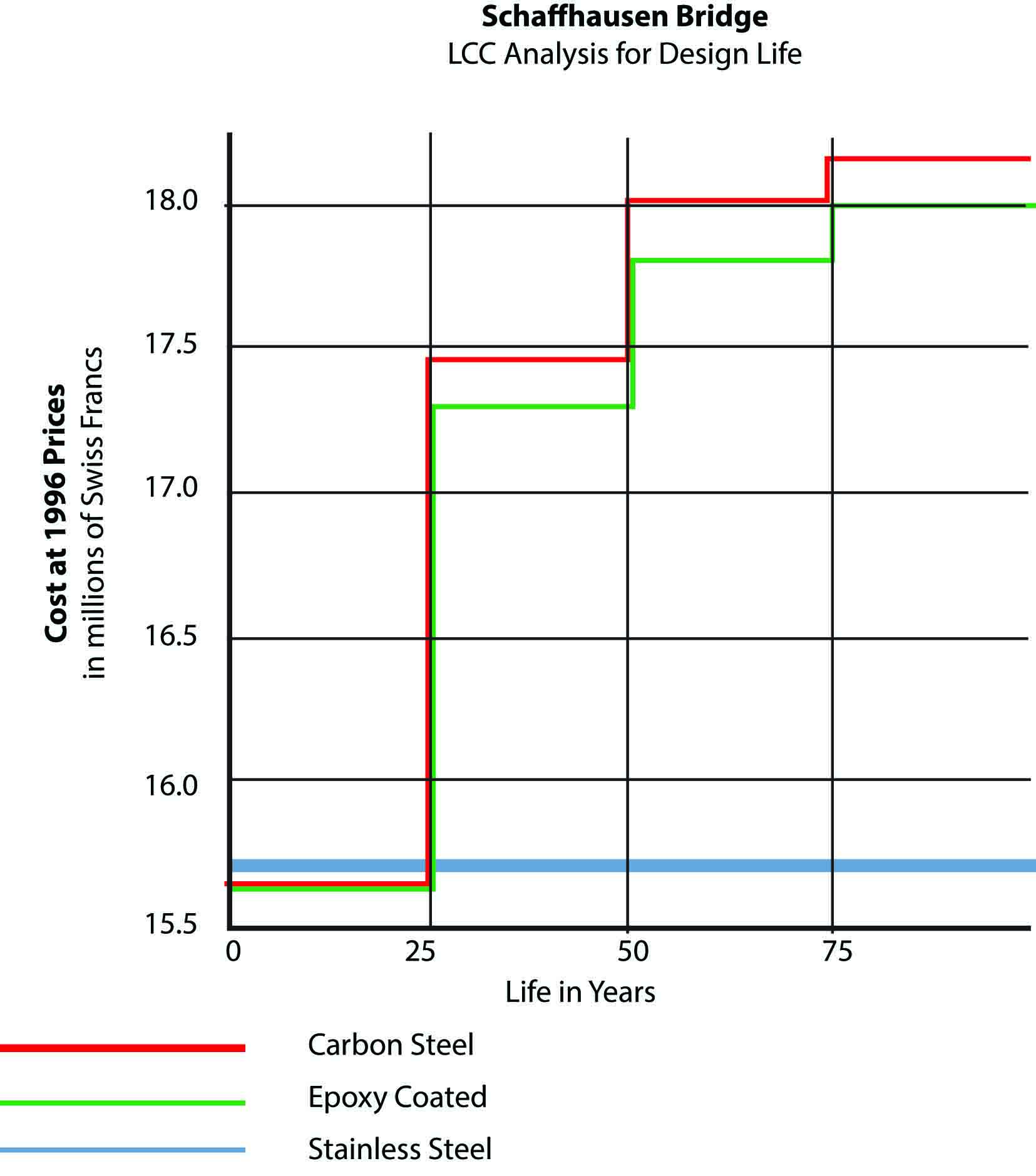
It describes the repair of the facade of an 18-storey apartment building in Alicante, Spain.(see front view, below) The 30 year-old building is located close to the sea. Cracks in the façade panels were observed and required replacement by new ones reinforced with stainless steel.
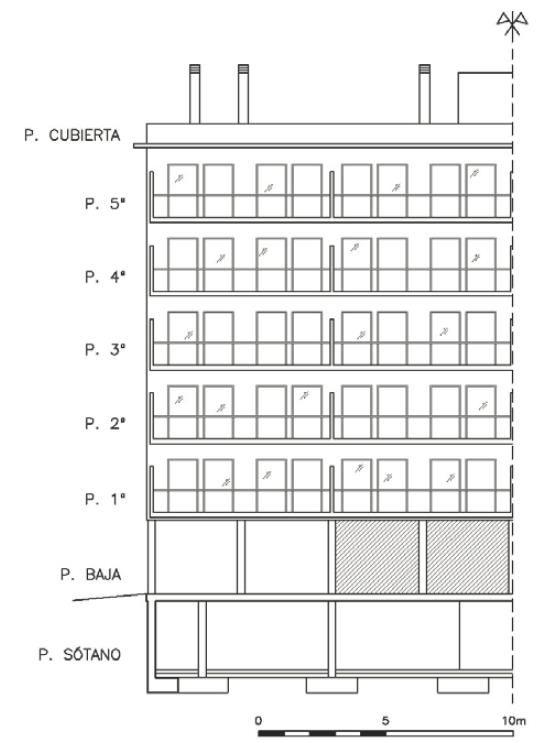
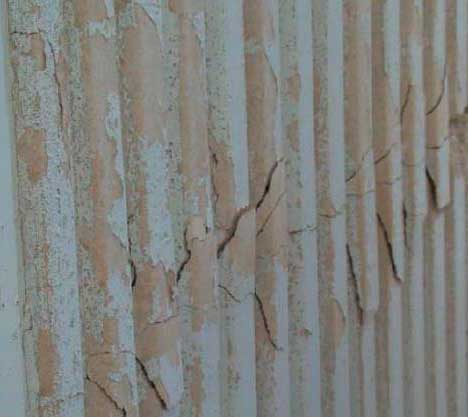
Compares the costs of two concrete structures ( i.e. apartment building and underground car park) reinforced with C-steel or with stainless steel. The use of stainless steel on the most exposed areas only leads to an increase of the construction cost of about 9€/m2 (about 2,5%) for the apartment building. A full replacement of C-steel by stainless steel would increase the cost by about 6%. This is not much in view of the longer life of the construction without major maintenance.
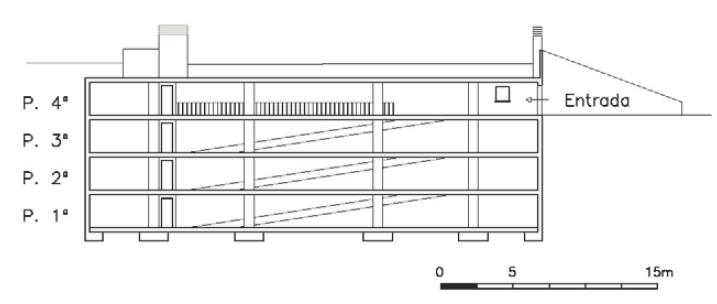
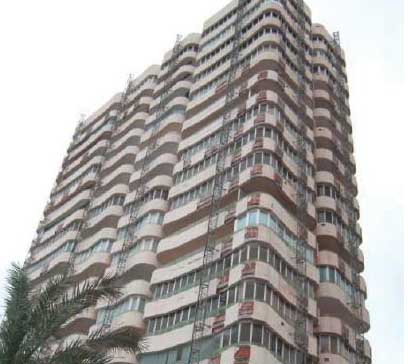
Fire Resistance [26 Chapter 11]
Building codes demand that structures should meet a proper level of fire resistance, usually 2 hours minimum, before collapse. One of the key parameters for reinforced concrete beams is the concrete cover (over the reinforcing bar).
Increasing the concrete cover will be efficient, however, only if the concrete does not exhibit large cracks or is deteriorated. This may occur over time as a result of corrosion.
Another problem, for thick concrete covers is that of "spalling", i.e. concrete cover cracking and flaking in case of fire. Ways to avoid this are enforced, but they add to the cost.
An efficient way to improve the fire resistance of reinforced concrete is to use stainless steel rebar. Stainless steels retain their mechanical properties better than carbon steel at elevated temperatures.
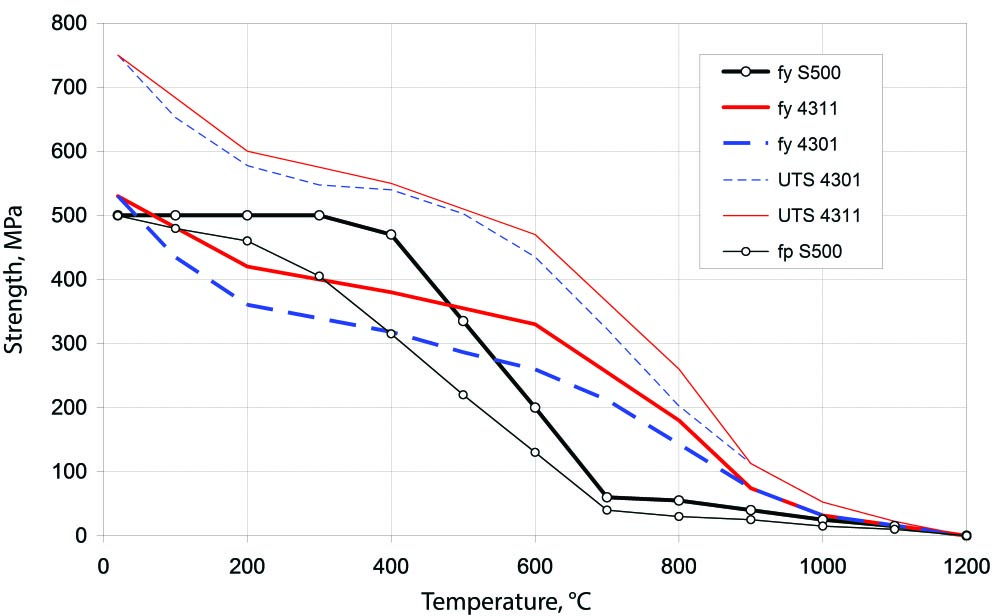
Note: EN 1.4311 (AISI 304N): stainless rebar data from worldstainless, EN 1.4301 (AISI 304) Eurocode data
Computer simulations show that the fire resistance of Stainless reinforced beams is much better than that of carbon steel reinforced ones.
The curve below obtained by computer simulation illustrates how a concrete beam reinforced with either C-steel or stainless steel (grade EN 1.4311 - AISI 304N) bends under load in case of fire (ISO 834 standard - cellulosic fire). Beam deflection increases with time (and beam temperature) until it cannot anymore bear the load.
Stainless steel almost doubles the time before the beam collapses. In addition, the high elongation provides a progressive onset of beam failure and therefore warns of imminent danger.
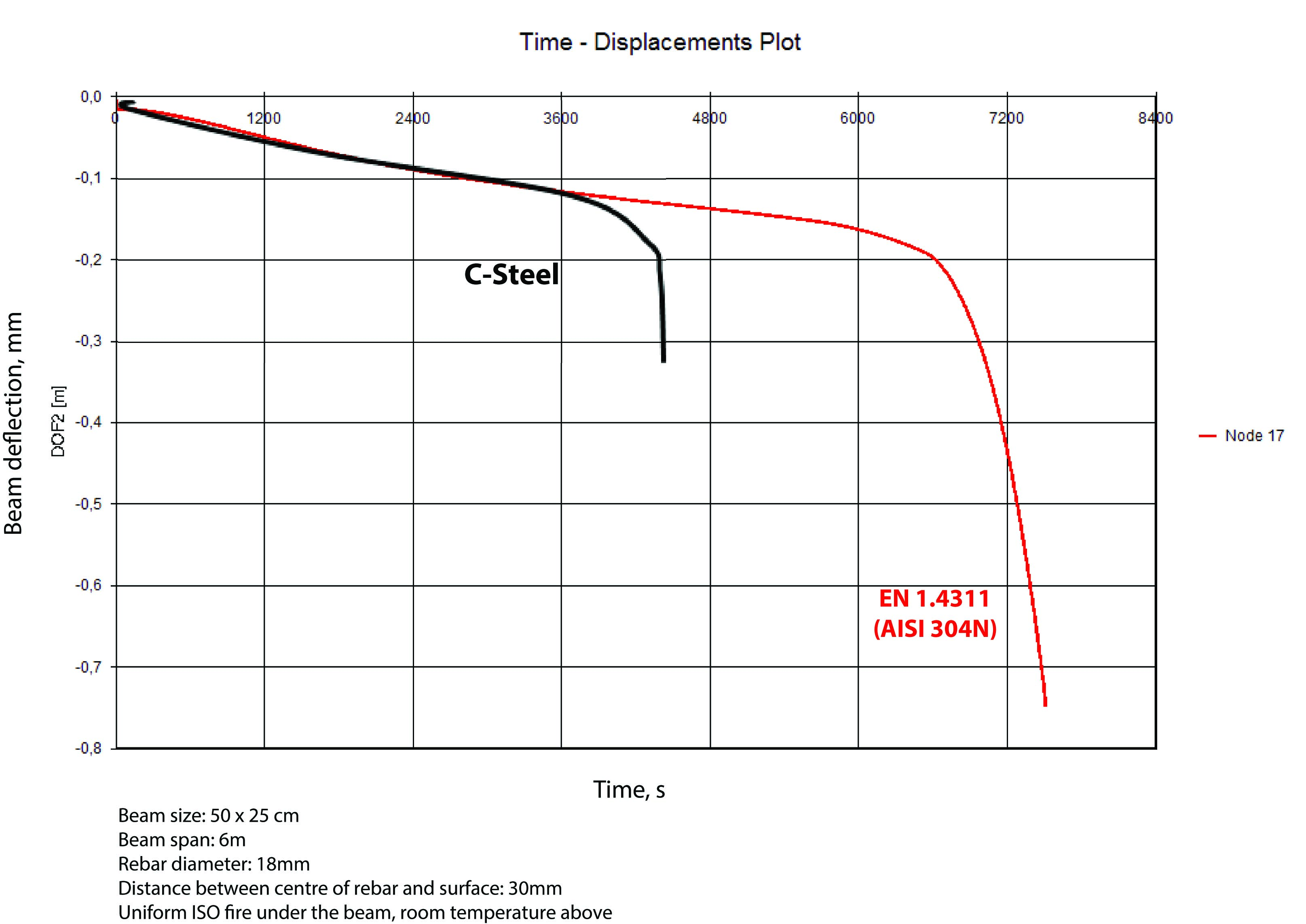
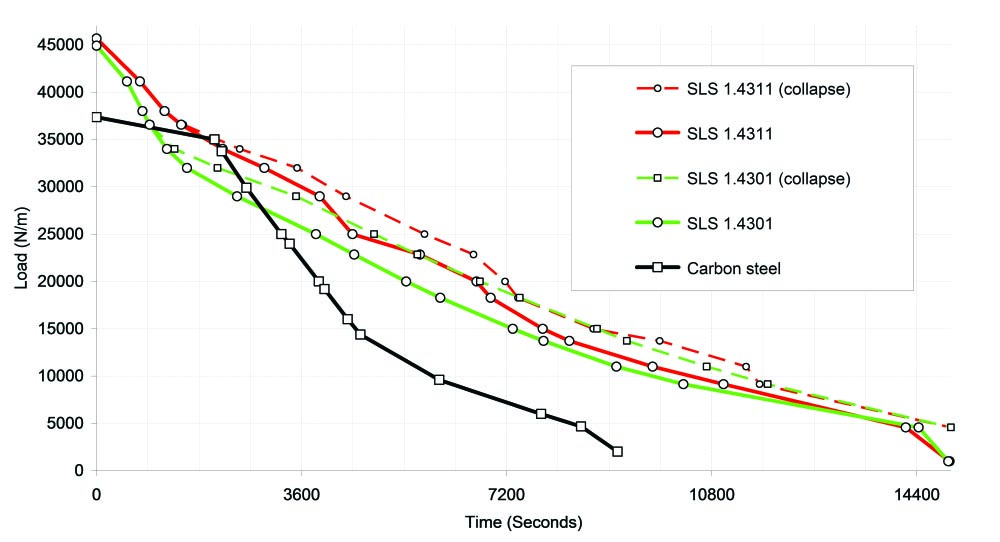
The increase in time before collapse brought by stainless steel reinforcement is an attractive alternative to the increase of concrete cover:
- it does not increase the weight of the structure, hence the load on the members
- it maintains the fire resistance in corrosion-prone structures
